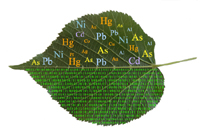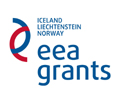|
Long-term National Monitoring
System of Bioaccumulation
of Airborne Heavy Metals
(BIOMONRO)
Project objectives
Objective 1.
Preparing protocols for
the use of species in biomonitoring programs
Activity 1.1 (A.1.1)
Identification of the species from Romania that could potentially be used as
bioindicators
Activity 1.2 (A.1.2)
Identification of the species from Romania that could potentially be used
as biomonitors
Activity 1.3 (A.1.3)
Assessment of the species from Romania selected as potential bioindicators
Activity 1.4 (A.1.4)
Assessment of the species from Romania selected as potential biomonitors
Activity 1.5 (A.1.5)
Preparing protocols for the use of the selected species in biomonitoring
programs
Objective 2.
Establishing the national
system of active and passive biomonitoring of heavy metals
Activity 2.1 (A.2.1)
Setting out the target areas
for passive and active biomonitoring of heavy metals at the national level
Activity 2.2 (A.2.2)
Using bryophytes in biomonitoring
Activity 2.3 (A.2.3)
Using lichens in biomonitoring
Activity 2.4 (A.2.4)
Using vascular plants in biomonitoring
Activity 2.5 (A.2.5)
Using other groups of organisms in biomonitoring
Activity 2.6 (A.2.6)
Active biomonitoring - case study: bioaccumulation of lead, cadmium,
nickel, arsenic and mercury
Activity 2.7 (A.2.7)
Passive biomonitoring - case study: bioaccumulation of lead, cadmium,
nickel, arsenic and mercury
Activity 2.8 (A.2.8)
Active biomonitoring - case study: bioaccumulation of heavy metals, others
than those stipulated in Law no. 104/2011, with negative effects on the
environment and / or human health
Activity 2.9 (A.2.9)
Passive biomonitoring - case study: bioaccumulation of heavy metals,
others than those stipulated in Law no. 104/2011, with negative effects on
the environment and / or human health
Activity 2.10
(A.2.10) Active biomonitoring - case study: bioaccumulation of heavy
metals of economic importance
Activity 2.11
(A.2.11) Passive biomonitoring - case study: bioaccumulation of heavy
metals of economic importance
Activity 2.12
(A.2.12) Developing
the national plan for active and passive
monitoring of bioaccumulation of
airborne heavy metals
Objective 3.
Identifying methods and techniques to reduce the concentration of airborne
heavy metals
Activity 3.1 (A.3.1)
The use
of forest belts and alignments as means to mitigate the effects of heavy
metals presence in the atmosphere
Activity 3.2 (A.3.2)
Methods and techniques to reduce
the presence of airborne heavy metals caused by mine
dumps
Activity 3.3 (A.3.3)
Using lichens and cormophytes in the extraction of heavy metals and
reducing their concentration in the soil and
in the atmosphere
Activity 3.4 (A.3.4)
Phytomining. Case Study: Extraction of some metals of economic importance
Activity 3.5 (A.3.5)
Developing the
national plan for the use of vascular
plants and lichens in the extraction of heavy metals and reducing their
concentration in the soil and in the
atmosphere
Objective 4.
Establishing the national system for collecting, integrating and processing
data on heavy metal biomonitoring data
Activity 4.1
(A.4.1) Providing technical support for setting up the national system for
collecting, integrating and processing
data on heavy metal biomonitoring data
Activity
4.2
(A.4.2) Completion of
databases
Activity
4.3 (A.4.3)
Preparing protocols for collecting
data on heavy metal
biomonitoring
Activity 4.4
(A.4.4) Preparing protocols for
integrating data on
heavy metal biomonitoring
Activity 4.5 (A.4.5)
Preparing protocols for
processing
data on
heavy metal biomonitoring
Objective 5.
Developing the national warning system in case of long term environmental
impact
Activity
5.1
(A.5.1) Setting warning levels for
the bioaccumulation of lead, cadmium,
nickel, arsenic and mercury
Activity
5.2
(A.5.2) Setting warning levels for
the bioaccumulation of
other heavy metals, with negative effects on the environment and / or
on human
health
Activity
5.3
Preparing warning protocols in case of long-term environmental impact
Activity
5.4
Testing the system
|











